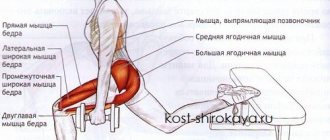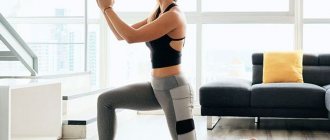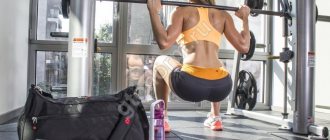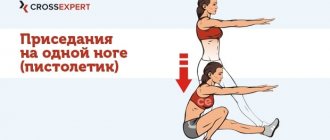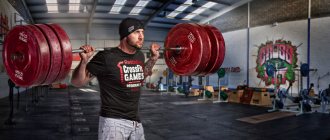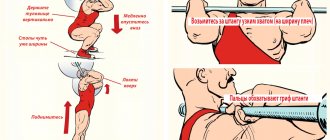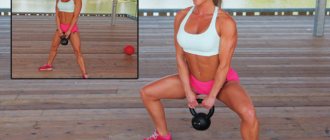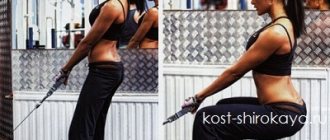Squats with a barbell on your shoulders are the best and most effective exercise for gaining leg mass. With the help of barbell squats, you will not only pump up your glutes, quadriceps and hamstrings, but also add strength and mass to your back, abs, shoulders and your entire body! Having mastered the correct technique, you can not only set records in the gym, but also become truly strong!
Training leg muscles for weight - basic and isolation exercises
Deadlift – Classic, Romanian and Sumo. Execution technique
Bench press
Very often in the gym during rush hour you can see a live line near the bench press, as if they are giving away breasts like Arnold's for half the price. At the same time, experienced bodybuilding coaches unanimously say that the bench press improves only one thing - the barbell press.
After the bench press, some athletes also decide to work their biceps, and finish the workout by pumping up their calf muscles - after all, you need to take care of your legs!
So let’s rejoice in the fact that the squat rack is almost always free and we can easily become stronger and bigger, while everyone else is pumping “cans” and doing abdominal crunches in preparation for the beach season.
Back squats are a basic exercise that is always included in a program to build muscle mass and increase strength. Only those who perform squats with a barbell on their shoulders can boast of a strong back and well-shaped buttocks. According to men, girls pay attention primarily to a wide back and pumped up biceps, but, as it turns out, “cans” lose their attractiveness in the absence of a good rear view. When the need arises to carry a girl in your arms from the first floor to the fifth, then only strong legs and back (read squats and deadlifts) can help you with this.
Important note for beginners : Instead of making you stronger, back squats can keep you from training for a long time. Without the right technique, you can easily injure your back, knees, or anything else—even break your neck! If it is not possible to take at least a couple of lessons from an experienced trainer, make friends with the guys in the gym and ask the most experienced ones to correct your technique, since mistakes are always more visible from the outside. As a rule, help can always be found.
At the beginning of your workout, be sure to do a warm-up and dynamic stretching, this will warm up your muscles and increase the range of motion during the exercises.
Types of squats
1 Back squats 2 Sumo squats 3 Bench/chair squats 4 Front squats (front squats) 5 Overhead squats 6 Scissor squats (on one leg)It is worth including in your program not only classic squats with a barbell on the shoulders, but also other types in order to better work out the different muscles of the legs and buttocks.
The number of sets and reps will depend on your goals at the time. If you need to gain muscle mass, it is recommended to perform 3-5 approaches (excluding warm-up ones) of 5-8 repetitions. During drying, most switch to multi-repetition training - 8-12 times in 3-5 working approaches.
Contraindications for squats with a barbell on the shoulders: problems with the spine, knee and hip joints, a predisposition to varicose veins and other diseases that the doctor may indicate. If you experience discomfort during squats (in your knees, lower back, etc.), then pay special attention to the correct technique (ask a trainer to watch you do the exercises). If pain or discomfort does not go away, be sure to consult a doctor. Inattention to yourself ends in injury.
Did you know that...[edit | edit code]
A Danish study found that there is a relationship between leg size and heart health. Scientists studied about 3,000 men and women over 10 years, studying the development of heart disease and overall mortality. The risk of developing cardiovascular disease was approximately 2 times higher in those with a leg circumference of less than 56 cm (at the hip), and they also had a higher overall mortality rate during these years. Body fat had no effect on the relationship between larger leg volume and a reduction in these risks. Scientists have concluded that greater muscle mass may protect against the development of cardiovascular disease and reduce overall mortality.[27]
Squats with a barbell on your shoulders
squatting technique with a barbell on the shoulders - video
Technique:
- heels at a distance slightly wider than the shoulders, toes turned outward by about 35 degrees (narrower foot placement increases the load on the quadriceps, but in any case, the toes should be slightly turned out so as not to injure the knees);
- the bar is placed on the shoulders and trapezoids, held with the hands from behind at a distance wider than the shoulders; move your elbows back (this position of the bar is used in weightlifting and bodybuilding; in powerlifting, the bar is placed a little lower, which allows you to take on more weight and use more muscles);
- bring your shoulder blades together and strain your back, chest forward;
- when lowering down, the body bends at the pelvic and knee joints, the back moves forward, and the butt moves back;
- you need to lower yourself so that your thighs are parallel to the floor or slightly lower (if stretching allows);
- body weight is transferred to the heels (they should not leave the ground);
- keep your back straight, avoiding rounding of the top of your back;
- tighten your abs (to support your back);
- the lower back is not rounded, the natural arch in the lumbar region is maintained (the load is transferred to the buttocks and quadriceps);
- the knees and hips do not extend forward beyond the feet, but move apart to the sides;
- You should not lift your head up, as this can lead to stretching; you need to look forward, keeping your neck in line with your spine;
- when lifting, you need to reach up with your chest, not your forehead;
- when lifting, the knees should not be brought inward;
- before lowering, inhale, hold your breath and tense your muscles;
- after rising, exhale.
Secrets and subtleties of the exercise
- Keep your core still and do not move your arms during the exercise.
- Raise your legs straight without bending your knees.
- Don't forget about proper breathing.
- Do not chase speed, perform ascents and descents at an average pace.
- In 10 minutes of training, 60–80 kcal are burned. By the way, reverse “scissors” are more effective in this sense.
- To burn 100-110 kcal in 10 minutes, do the exercise in the pool . The effect of 40 minutes of such training can be equal to the effect of strength training.
- For best results, 3-4 workouts per week in conjunction with other exercises to strengthen the abdominal muscles.
- During one workout, do 3 sets of 45-60 seconds each. The number of swings depends on your physical fitness.
- A noticeable effect from the exercise can be seen 2 months after the start of training.
Performing the scissors exercise with dumbbells
The scissors exercise can be made more difficult by doing it with dumbbells.
The “scissors” exercise is distinguished not only by its accessibility, but by its benefits and effectiveness. Vertical and horizontal swings can pump up your hips and abs in a relatively short time. But for impressive results you need constant physical practice. And most importantly, remember - everything has its time. Don’t overestimate your capabilities and don’t rush to move to the next level, and then you will be rewarded with a flat tummy, slender legs and elastic buttocks, and you will be able to leave only positive reviews about the exercise.
Squats on a bench/chair
To practice the technique of squats with a barbell on your shoulders, you can practice squatting on a chair/bench. You need to choose a chair of such a height that when sitting, your thighs are parallel to the floor and your entire foot is on the floor. The exercise is useful for those who cannot perform classic squats in full amplitude (so that the thighs are parallel to the floor or lower). In powerlifting, the exercise is used to practice explosive lifting from the bottom of a squat.
video - Squats on a bench/chair.
Precautionary measures
Scissor exercise: safety description:
- Maintain a neutral spine position (do not arch/arch your back during movements).
- Work not with your legs, but with your abs - make sure that the target muscles are constantly tense.
- After finishing your workout, be sure to stretch your abdominal area and hip flexors/extensors.
- For beginners, you can use a bolster under your lower back, put your hands under your buttocks (removing unnecessary stress from your back), lean on your elbows, and not lay your body completely on the floor/mat.
Thus, it is not for nothing that scissors are considered one of the most effective exercises for working out the abs: they tone the abdominal muscles, help reduce the thickness of the subcutaneous fat layer on the abdomen, improve the balance of the body in general and strengthen the core in particular.
Sumo squats - wide stance
Sumo squats work well on the adductor muscles of the thigh (the inner part) and are especially useful for those whose knees are brought together in classic squats, instead of turning outward - this is precisely because of weakness of the adductors.
video - wide sumo squats
Technique:
- place your feet wider than your shoulders;
- turn your socks 120 degrees;
- squat down so that your thighs are parallel to the floor and your shins are perpendicular;
- the buttocks are pulled back and the back is slightly forward;
- keep your back straight, do not round your shoulders;
- tighten your abs to support your back;
- When lifting up, tense your gluteal muscles.
Benefits and Benefits of Exercise
Due to the fact that “scissors” affect the abdominal muscles, as well as the superficial and deep muscles of the thigh, the following elements of the body are improved when performing the exercise:
- abs (depending on the goal and the applied load, you can get both a flat tummy and the coveted cubes);
- a waist that becomes more beautiful and thin;
- due to the tension of the transverse muscle, correct posture is formed;
- thighs become more toned;
- Legs become slimmer due to tension in the thigh muscles.
Front squats (front squats)
This type of squat increases the load on the front of the thigh – the quadriceps.
video - front squat technique (with a barbell on the chest)
Technique:
- the bar is placed on the shoulders and chest, grasped with the hands from above crosswise, or with a heavy grip;
- the position of the feet is slightly narrower than in squats with a barbell on the shoulders, the toes are also turned outward;
- the back is kept as vertical as possible;
- The weight for front squats with a barbell on the chest should be taken less than for squats with a barbell on the shoulders.
When performing front squats with a barbell on the chest, the most common grip is a cross grip. The weightlifting grip is more difficult to perform, as it requires good mobility of the shoulder joints and flexibility of the muscles of the shoulders and triceps. But, having mastered this grip, you will be able to better control the technique of performing front squats - your upper back will not round and your chest will not fall down.
Stretches for working with a weightlifting grip:
video - stretching
Common Mistakes
The first few times it is better to perform squats with dumbbells under the supervision of a trainer so that muscle memory is developed. The most common beginner mistakes:
- Turning the knees inward. This is how weakness of muscles and ligaments usually manifests itself. When squatting, you need to control the position of your knees in the mirror, if possible.
- The heels are off the floor. When performing this type of exercise, the foot should always be completely on the floor; this is important for proper distribution of the load.
- Back bending. When moving from the starting position to the squat, you need to control it and keep it as straight as possible.
- The thighs are not parallel to the floor. They should not be at an angle; when lifting, this will lead to high stress on the knees.
To avoid mistakes, it is better to set up the technique with a trainer. You can control yourself by doing exercises in front of the mirror. Gradually, doing squats correctly becomes a habit and no longer seems difficult.
To develop the correct technique and avoid numerous mistakes, it is better to learn how to squat with a trainer.
Overhead squats
This type of squat adds load to the upper body, including the shoulders, trapezius, and torso stabilizer muscles. When performing overhead squats, you should start with small weights, as this exercise is very dangerous. First, warm up the shoulder joints with a stick or elastic band (as shown in the video).
video - overhead squats
Technique:
- the barbell is picked up with a grip wider than shoulder-width and raised above your head;
- During a squat, the arms always remain in a plane perpendicular to the floor;
- squats are performed similar to front ones (the back is held in the maximum possible vertical position, with minimal forward bending).
A beginner should first learn the classic squat technique and practice it well before trying the overhead squat.
Execution options
- Walking lunges . This option consists in the fact that the exercise is not performed alternately with the right and left legs, but as if constantly. The athlete steps forward, constantly moving the leg forward and alternating legs. This movement is mistakenly considered an exercise for the buttocks; in fact, the load is evenly distributed between the gluteal muscle and quadriceps. But what this exercise really does is burn a lot of energy. The movement is very energy intensive, and therefore it is used for all cases where it is necessary to expend a large number of calories. In addition, a walking lunge can be a good option for developing running speed and step depth;
- Front lunges with barbell . They differ in that the barbell is taken by the athlete on the clavicle bones, the hands are positioned as with a barbell in a front squat, that is, either crosswise or with raised elbows and wrists. The peculiarity of the frontal hold of the projectile is that it does not give the athlete;
- Sitting in different strides . In this version of the lunge, you do not need to return to the starting position every time, placing one foot next to the other. A split squat is performed, that is, a lunge forward, and all repetitions are in this position, and only then the leg is placed. This option is more convenient for those people who perform workouts with heavier weights.
- Long stride movement . This option is used by those who want to make their buttocks a priority. Long stride lunges are not powerful and require a moderate amount of effort to do them. Typically, the long stride movement is performed in a split manner so that the athlete does not overload the muscles.
Lunges with a barbell: execution technique

